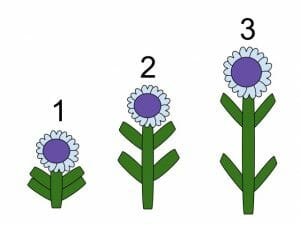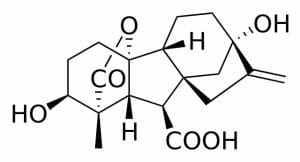Gibberellin Definition
Gibberellin is type of plant and fungal hormone. While its role in fungal development is not as clearly understood, it has been extensively studied in plants. Gibberellin is one of 5 major groups of plant hormones, the others being auxins, cytokinins, ethylene and abscisic acid.
Gibberellin was originally purified and identified by Japanese scientists studying a fungal rice disease in the 1930’s. By the end of the decade, they had extracted gibberellin from the fungus attacking the rice crops. Upon applying the extracted gibberellin solution to healthy crops, they noticed it had the same effect. Further tests in the United Stated in the 1940’s and 50’s revealed many more functions of gibberellin. Gibberellin has the ability to overcome dormancy in seeds, extend the length of cells and encourage division, and even has hormonal and signaling roles in the fruiting and senescence processes.
Gibberellin Function
Seed Germination
A dormant seed is dry, and thus little to no metabolic activity can occur. This allows a seed to remain dormant for an extended period of time. Most seeds, upon surviving the winter, are exposed to rain in the spring. This water saturates the seed, and allows metabolic processes to resume. Gibberellin is an essential hormone in this process.
As the embryo begins growing, it needs access to more energy. The embryo releases gibberellin molecules, which make their way to the aleurone layer, which surrounds the endosperm. The endosperm is a large mass of cells which stores starch, fats, and proteins for the developing embryo. The aleurone layer, upon receiving the signal from the gibberellin molecules, begins producing enzymes to digest the endosperm and provide nutrients to the growing embryo.
The gibberellin molecules act on several pathways, most of which increase DNA transcription for certain genes which produce the required enzymes. The aleurone layer releases amylase enzymes, which will convert the starch molecules into glucose. Glucose is the main energy source for the growing embryo, and it has not yet sprouted, so it cannot produce glucose through photosynthesis. Gibberellin molecules also stimulate the production and release of proteases, designed to break apart proteins into amino acids, and lipases, which break apart lipid molecules like fats and oils. Together, these enzymes digest the endosperm and allow the embryo to grow rapidly.
Stem Elongation and Other Functions
Once a plant has sprouted past the surface of the soil, the endosperm is long gone. The plant must now rely on photosynthesis for food. However, the role of gibberellin does not stop at the seed. Gibberellin is responsible for many aspects of plant development. Further, plants produce many forms of gibberellin molecules, which act on different parts of the plant. In the image below, you can see the effects of a specific gibberellin applied to a plant.
In number 1, no gibberellin was applied. Plants 2 and 3 both had gibberellins applied, with plant 3 receiving the highest dose. Gibberellin here encourages the plants to increase their internode length, or the length between their leaves. In many plants, the regulation of gibberellin is an important natural process which regulates their height due to this process. At the cellular level, gibberellin is influencing the balance of proteins. In doing so, it encourages cell growth and elongation in the stems and between nodes.
In some species of plant, gibberellin is involved in many more processes. These include flowering, fruiting, and senescence, or the natural death of leaves and other plant parts. Interestingly, many genes which regulate and adjust gibberellin levels are influenced by the temperature. Thus, when the temperature changes during seasonal change, the plants react to this as gibberellin levels change. This starts off many processes such as flowering and fruiting.
Gibberellin molecules are involved with and interact with other plant hormones. The auxin level, for example is directly related to the gibberellin level, and the two complement each other. Ethylene, on the other hand, tends to degrade gibberellin levels. Plants use these hormones, which respond to different inputs, to balance and react to inputs from the environment. These inputs signal various environmental conditions, which the plant is keen to take advantage of.
Gibberellin Structure
Gibberellin molecules of different types are synthesized in many different parts of the plant. Currently, there are over 100 uniquely identifiable gibberellin molecules. These molecules are synthesized in many cells of the plant, but tend to be concentrated in the roots. This is different from auxin, which tends to concentrate at the apex.
Gibberellin is a diterpenoid, which is a familiar and highly represented molecule in biochemistry. It forms the basis of molecules like Vitamin A and Vitamin E. Seen below is Gibberellin A1, which was the first identified gibberellin.
Other gibberellins have the same basic structure, but have various side groups attached. These groups affect where and how the gibberellin acts, which is how gibberellin can have so many diverse and unique functions in different tissues.
Uses of Gibberellin Commercially
Commercially, gibberellin is obtained from fungi, not plants. Plants produce very little gibberellin and are equally as hard to grow compared to fungi. The gibberellin fungi produce is active on plants, and can cause them to germinate from seeds or increase internode length. While still not commercially profitable in all plants, gibberellin treatments are used on a variety of human foods.
Seedless grapes, for example, have a hard time becoming very large without the use of gibberellin treatments. The molecules of gibberellin are typically sprayed onto the vines, where they increase the amount of water and sugar stored in each fruit. This is great for vineyards and grape-growers, who can significantly increase their harvest.
Interestingly, another use of gibberellin is removing it from plants. Semi-dwarf rice, a species which grows quickly and efficiently, was developed by selecting for strains in which the genetic codes for producing gibberellin molecules were wiped out. This effectively made the plants gibberellin deficient, and significantly reduced their height. While this may seem like a bad thing, the rice actually grows much quicker and produces the same amount of rice. Still other uses of gibberellin include using it on cucumber flowers, where it promotes all-male flowers. This allows farmers to obtain the pollen of a desirable cultivar, for use in hybridization with other varieties. An underdeveloped but interesting application of gibberellin is in eliminating the cold requirement for flowers. Typically, a cold spell is required to promote gibberellin production in the plant. By spraying the hormone on directly, this process is avoided and ornamentals will flower directly.
Quiz
1. A farmer is growing two tomato plants. One he allows to grow naturally, only watering it regularly. The other plant he supplements with gibberellin. Which of the following is NOT a possible outcome?
A. The gibberellin plant will be taller
B. The leaves of gibberellin plant will be much larger than the regular plant
C. The gibberellin plant may die
2. A scientist is testing gibberellin on some seeds. One batch of seeds is left as the control, with no treatment. The other batch is sprayed with a concentrated gibberellin treatment. What is the expected outcome?
A. The control seeds will sprout less, and slower
B. Both groups will sprout, but the gibberellin seeds will be bigger plants
C. Neither group will sprout, but for different reasons
3. When you “nip the bud” of a plant, or tear off the axial bud, auxin production in the top of the plant stops and the auxin levels drop. This also lowers the gibberellin level. What benefit does this give the injured plant?
A. Growth stops, allowing for repair
B. No benefits
C. This increases internode growth
References
- Bruice, P. Y. (2011). Organic Chemistry (6th ed.). Boston: Prentice Hall.
- McMahon, M. J., Kofranek, A. M., & Rubatzky, V. E. (2011). Plant Science: Growth, Development, and Utilization of Cultivated Plants (5th ed.). Boston: Prentince Hall.
- Nelson, D. L., & Cox, M. M. (2008). Principles of Biochemistry. New York: W.H. Freeman and Company.
Gibberellin


No comments:
Post a Comment